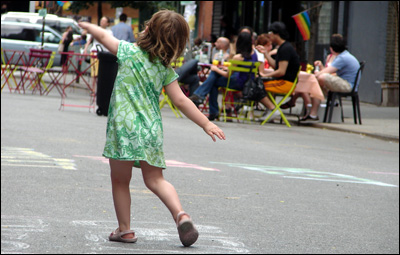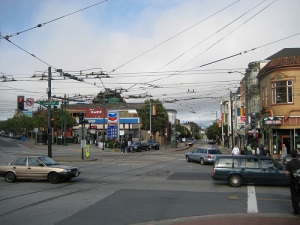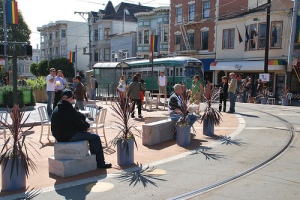We’ve moved…
Please find us at our new url: http://www.sfgreatstreets.org.
Join us for a Party
Art – Streets – Life
Benefit and Mural Opening
&
Benefit for the new San Francisco Great Streets Project
Beer, food carts, music, Valet Bike Parking and an unveiling of the Great Streets Project presentation — come enjoy an evening amongst friends and find out more about the SFBC’s latest project, the Great Streets Project.
September 10, 2009
6-9 pm
337 Shotwell Street
San Francisco, CA
Valet bike parking
Space limited!
All gifts are tax-deductible
Purchase here

Temporary City Beaches

There are many ways to reprogram city streets to provide free fun and relaxation opportunities for an overworked, financially stretched population. In 2002 Paris launched its Paris Plage system, bringing in sand and umbrellas to turn the Georges Pompidou Expressway, which runs by the Seine, into a free beach. In 2007, the Mayor of Mexico City also carted in sand to turn areas of the hot city into free beaches. Both programs have attracted huge, growing crowds, and continue to thrive.
Though San Francisco is relatively rich in beaches, the spirit of these instant beaches begs the question of how we can re-imagine our own streets to provide space for families, all kinds of San Franciscans and visitors to relax and have fun. Sunday Streets is a great, successful example of an event-based approach to using city streets for better social and health purposes. A more semi-permanent installation in the spirit of these seasonal beaches, is the next step.

Internship
The San Francisco Great Streets Project is looking for an intern to help with street based research. You will work directly with the project director to study street performance for project sites around the city. This is a great opportunity for someone with a strong interest in livable streets practices and background in quantitative research who wants to get a better understanding of how to institutionalize livable streets practices in a major city, or just get a feel for the industry. People with computer programming skills especially encouraged, though the skill is not required.
Responsibilities
- Help measure demonstration projects, including informing the selection of measurement tools
- Help research best practices
Benefits
• This is an unpaid internship
• Length and hours are flexible
• Indoor bike parking provided
To apply
Send a cover letter and resume to Kit Hodge at kit [at] sfgreatstreets DOT org immediately. No calls.

New York City Enhances Its Public Realm with Weekend Walks
This summer, community groups in five boroughs of New York are creating thirteen temporary pedestrian streets called Weekend Walks. Local Business Improvement Districts are encouraging pedestrians to take advantage of the carfree public spaces to get to know their community. Similar to our Sunday Streets, Weekend Walks creates safe places for neighbors to gather and to feel safe walking in their community without any other agenda. The temporary and DIY nature of these day-long street openings, much like the Pavement to Park trial plazas, has allowed these open spaces to come to fruition quickly, with little expense or contention, then return to a thoroughfare just as easily. Perhaps as these neighborhoods enjoy the benefits of these walkways and seating areas others will be inspired to open their streets to the community as well.

Great Streets Project Sits Down with Enrique Peñalosa
From July 5 – July 8, the San Francisco Great Streets Project, in cooperation with the Institute for Transportation and Development Policy, had the distinct honor and pleasure of welcoming Enrique Peñalosa to San Francisco.
As Mayor of Bogotá, Colombia from 1998-2000, Mr. Peñalosa led massive efforts to rebuild the city in areas of transportation, land use, housing for the poor, and pollution abatement. He rejuvenated the city’s public spaces by creating parks from areas previously overrun by crime and drugs and establishing a dynamic pedestrian promenade from what had been a deteriorating and congested downtown avenue. In 2000, Mr. Peñalosa instituted the first car-free day in Bogotá, a milestone for which he won the Stockholm Challenge Award. He worked hard to involve citizens in the revitalization of some of Bogotá‘s marginal neighborhoods, planted more than 100,000 trees, and jumpstarted a highly successful bus-based rapid transit system that is a shining example of sustainable and equitable transportation for the world to see.
Mr. Peñalosa has been awarded the Eisenhower Fellowship and the National Simon Bolivar Prize, and he is currently a visiting scholar at New York University and senior international advisor to the Institute for Transportation and Development Policy. He was formerly economic secretary to the President of Columbia, as well as Dean of the Business Administration faculty at Externado de Columbia University.
While in San Francisco, Mr. Peñalosa met with interested citizens, urban planners, government officials, and business leaders. We had the chance to sit down with him to ask him a few questions about his work, his motivations, and moving forward together to create a better San Francisco.
Great Streets Project: Mr. Peñalosa, thank you so much for taking the time to share your wisdom and inspiration with us. Can you talk about what motivates and excites you about this work?
Enrique Peñalosa: I think it’s very exciting to participate in the creation of environments where people are happier—where life is better, where there is more equality, and happiness.
GSP: So, for advocates like us who might feel the same way, what is the advice for how to make change in our own cities?
Enrique Peñalosa: Well, more than advise I just have to congratulate you; you do a wonderful job. I will just say that most of the time in societies, people have been so used to the way things are, that even some very horrible situations have seemed normal. Perhaps today many things that are really inhuman—and which in a few hundred years will seem unimaginable—are surrounding us all over the place. Perhaps we can invent better ways of organizing life.
GSP: After walking around San Francisco and seeing Market Street, how do you think that it can become a truly great street?
Enrique Peñalosa: Well, Market Street is a difficult case; it has so many good ingredients, and yet it seems it does not attract enough people. I think the traffic of bicycles on Market Street justifies a top-quality bicycle lane—a protected bicycle way. That would be a nice improvement. It seems that in many areas of San Francisco you could have higher densities, higher buildings. You could easily put double the population that it has now without having any twenty-story or fifty-story high-rises, just with six-story high, seven-story high buildings. But I cannot really know what the ingredients would be, I really cannot claim to know, but it seems that there are many good ingredients on Market Street.
The thing that we most underestimate and undervalue is dreams. Dreams tend to be just some sort of a game that doesn’t have any worth. I think it’s the most difficult thing to do—to dream, to imagine. Of course, it is even much more difficult to construct a shared dream. I think the first thing is to look at many details, and then to propose changes, to propose renderings, perhaps. But those dreams have to be—at least initially—as free from restrictions as possible. You cannot begin by saying what is not possible. Later in the process we will figure out what is possible and what is not, but at the beginning you cannot start with the restrictions.
GSP: When we try and make improvements like this, what is the thing that usually stops them or slows them down?
Enrique Peñalosa: Well in general at this time in history, we are trying to retake our cities from cars, to which we gave them in the twentieth century. The twentieth century was disastrous for human habitats. We really made cities for cars and not for people. And therefore at this time most of the improvements are improvements trying to make cities more for children, more for wheelchairs, more for the elderly, more for humans. Sometimes taking away some space for cars making wider sidewalks or taking a few lanes out to make a truly great promenade, continuing sidewalks at grade so that it is clear that it is cars who are entering the pedestrian space and not vice versa. But you have to have a city, which in every detail shows that human beings are sacred. There are a thousand ways of doing it, but in short it’s very simple—almost too simple—to basically make cities more humane, more for people.
GSP: So when it comes down to it, who is responsible for making this possible?
Enrique Peñalosa: Well I think eventually you have to participate in politics somehow. Politics is the way societies are organized to make decisions. It’s not a matter of being a politician or not, but our society is organized in such a way such that government—at some level, there may be different ways that are more or less participatory—at some point the people who are elected hold the possibility to make decisions that change everything—faster or slower, with wider or narrower, with more or less consultation. So think that’s inevitable—to participate in politics somehow.
GSP: Mr. Peñalosa, thank you so much for your time.
Enrique Peñalosa: Thank you.
Voice Your Opinion on the Next Pavement to Parks Project
On Tuesday, July 28th the San Francisco Planning Department is holding a public meeting to discuss one of the next Pavement to Parks projects, Showplace Triangle, at the intersection of 16th and 8th Streets. (See Streetsblog for their article on this project.). The Planning Department is seeking input from community members on what the public space should look like and how it should be utilized. This is a great opportunity to help shape our city.
Please join us to share your vision of the new trial plaza.
TUESDAY, JULY 28, 2009
6:30 PM
Axis Cafe
1201 8th St. at 16th St.
17th Street Trial Plaza Builds Sense of Community Character
The 17th Street Plaza has been monitored and evaluated since its implementation as part of the Pavement to Parks trial process. Before and after the opening of the plaza, The Great Streets Project collected pedestrian counts, street perception surveys and timed photographs to analyze how the space was being utilized. We’ve compiled our observations into the 17th Street Trial Plaza User and Perception Analysis. We are also finalizing a survey of the businesses in the area to gauge their perception of the impact on their stores.
Some of the most interesting findings of our work were from the pedestrian surveys, where we could get a sense of how people viewed the area. Residents of the Castro neighborhood who felt a strong sense of community character rose from 76% to 89% after the plaza opened and those who considered the pedestrian experience of the area as positive rose from 79% to 84%. This was an unexpected but extremely interesting development, and one of the oft-overlooked impacts of improving street spaces; this is not just a “transportation” project, it’s a community building project. In the not surprising category, given that there was nowhere to gather before the trial plaza, visitors are staying in the area as much as eight times as long and are now actively engaging with each other.
Based on such observations and wide community feedback, the trial period for the plaza has been extended for four more months. We will continue to monitor the use of this space and publish our findings.
Special thanks to all of the volunteers that have helped collect this data.
Before…
… After

Enrique Penalosa Inspires San Francisco


Enrique Penalosa, former Mayor of Bogota, internationally acclaimed consultant to world leaders and, now, recipient of the prestigious Goteborg Award, inspired crowds of San Franciscans in a whirlwind three day trip last week. The San Francisco Great Streets Project organized meetings for Penalosa with Mayor Newsom, key decisionmakers in city agencies, the Chamber of Commerce, and many more people.
Penalosa is often known for his role in creating Transmilenio, Bogota’s Bus Rapid Transit System, and for expanding his city’s version of Sunday Streets to 120 kilometers of Bogota every Sunday for seven hours. But his message to San Francisco was not to adopt any particular project, but rather to rethink how we see our streets; they are more than a means, they are an extremely valuable end in and of themselves. Moreover, he reminded us that all decisions about street design and management are political, not technical.
His message could not have come at a more opportune time for San Francisco, with the passage of the city’s bike plan, successful expansion of Sunday Streets and now the City’s new trial approach to creating new public spaces through the Pavement to Parks initiative. This is the time to start thinking about — and acting upon — even more ambitious plans for our city’s streets. As Penalosa asked, how much would your life improve if there was a miles long pedestrian promenade where you could stroll, shop, sit or bike just a few blocks from your home?
Coverage of the events at: SF Chronicle, SF Streetsblog and Ecoworldy
Special thanks to ITDP for helping make Penalosa’s visit possible.

Streetsfilms focuses on the 17th Street Plaza
We’re pleased to share a new short documentary produced by Paul Jaffe of Streetfilms that looks at the process that was involved in constructing and opening the 17th Street Plaza, as well as the responses of people utilizing the space. Thanks, Paul!

